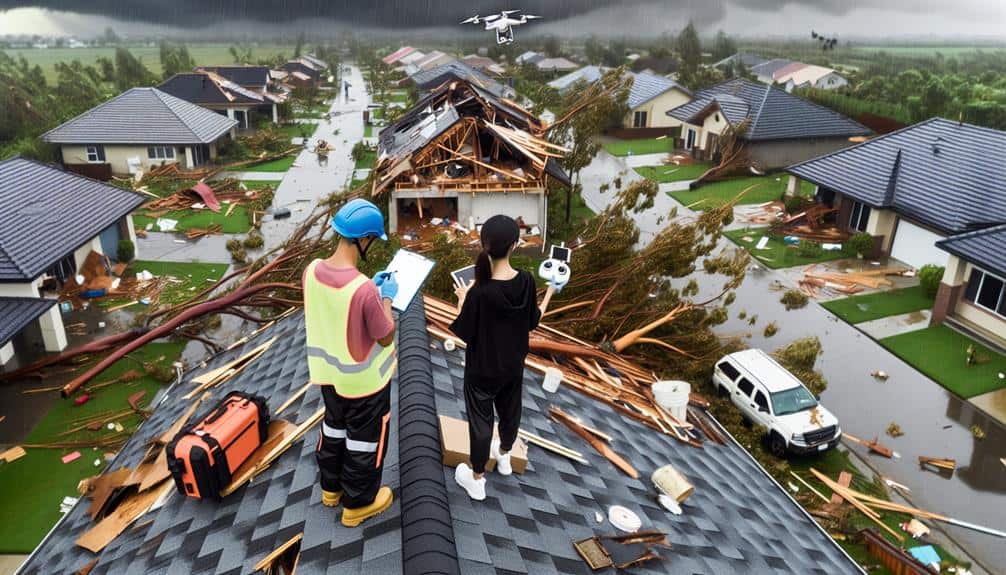When documenting hail damage, let's begin by thoroughly examining all areas, such as the roof, siding, windows, and vehicles for any dents, cracks, or water leaks. We should capture clear photographs from various angles and distances to accurately record the damage. Detailed notes are crucial, so we'll record the size, position, and scope of each damage meticulously. Utilizing measuring tools like tape measures and digital calipers guarantees accurate size and depth measurements. Seeking advice from experts will validate the damage and offer reliable evidence. To fully maximize our approach, we'll delve into each step more comprehensively.
Key Points
- Conduct a thorough damage assessment of your property, including roof, siding, windows, gutters, and vehicles.
- Capture clear, detailed photographs from multiple angles and distances to document the hail damage accurately.
- Record precise and descriptive notes about the size, location, and extent of each damage.
- Use precision measuring tools like tape measures and digital calipers to accurately document the size and depth of dents and cracks.
Inspect the Damage Thoroughly
Let's start by systematically examining every part of the property to identify and document all hail damage. First, we need to conduct a detailed damage assessment. Start by inspecting the roof, as it's often the most affected area. Look for dents, cracks, and broken shingles. Don't forget to check the gutters and downspouts for dents or clogging caused by hail debris.
Next, we should inspect the siding and windows. Look for cracks, chips, or any other signs of damage on the exterior walls and window frames. It's important to check for water leaks inside the house, as hail damage can sometimes lead to roof leaks that aren't immediately visible.
By thoroughly documenting these damages, we can build a solid foundation for our insurance claims. Note the size, location, and extent of each damage.
We should also inspect any vehicles parked outside, as they can have dents and broken glass from hail impact.
Take Clear Photographs
To make certain we've strong evidence for our insurance claim, we need to take clear and detailed photographs of all hail damage.
First, let's make sure we capture the damage from multiple lighting angles. Natural light is ideal, but if the weather is overcast, using a flashlight or another light source can help highlight the dents and cracks. We should avoid shadows that may obscure the damage.
Next, taking photos from various distances is essential. Start with a wide shot to show the overall area affected, then move closer for detailed shots. Close-ups should focus on specific damage, such as dents or cracks, making sure the details are sharp and easy to see.
After we've taken our photos, using editing software can improve the clarity and visibility of the damage. We should avoid altering the photos to misrepresent the damage, but slight adjustments to brightness, contrast, and sharpness can make a significant difference.
Record Detailed Notes
In addition to capturing photographs, we need to record detailed notes that describe the extent and specific locations of the hail damage. Our notes should be meticulously organized to guarantee an accurate and thorough damage assessment.
Start by categorizing the affected areas—roof, windows, siding, and vehicles. For each category, we should document the exact location and severity of the damage.
Let's be specific: note the size and depth of dents on vehicles, the number of broken shingles on the roof, and the extent of any cracked or shattered windows. Descriptive terms like 'quarter-sized dents' or 'multiple broken shingles in the northwest corner' help create a clear picture. This level of detail makes our records far more useful when it comes time to file an insurance claim or coordinate repairs.
Effective note organization is essential. Using a structured template or checklist can help us capture all necessary information without missing any important details. We should also timestamp our notes to provide a clear timeline of when the damage occurred and when it was recorded.
Use Measuring Tools
Accurate measurements are crucial for documenting hail damage effectively. Without precise data, our claims or repairs might be questioned or delayed. To ensure we're collecting the best information possible, we should use precision tools designed specifically for this purpose.
First, let's start with a tape measure or a digital caliper. These tools help us determine the diameter of the hailstones and the size of the dents they leave behind. By recording these measurements, we can provide clear evidence of the extent of the damage. A standard ruler can also work, but digital calipers offer more precision and ease of use.
Next, using a depth gauge allows us to measure the depth of any dents or cracks accurately. This tool is particularly useful when appraising damage to vehicles or metal surfaces. By knowing the depth, we can better understand the severity of the impact.
Consult With Professionals

While our tools provide valuable data, consulting with experts guarantees we interpret and document the damage accurately. Professionals bring expertise that can greatly strengthen our case when filing insurance claims. Their trained eyes spot nuances we might miss, making sure every detail of the hail damage is accounted for.
Engaging experts early in the repair process can save us time and money. They can provide thorough assessments that streamline interactions with insurers and contractors. Documentation from a certified expert can serve as credible evidence, potentially expediting our claims and reducing disputes.
Moreover, professionals help us understand the full scope of necessary repairs. They can outline the extent of the damage and recommend the best course of action, from minor fixes to extensive restorations. This not only aids in planning but also ensures we're not overlooking crucial repairs that could lead to future complications.
Involving experts also protects us from potential pitfalls. They can advise on common mistakes and guide us through the complexities of the repair process. By leveraging their expertise, we guarantee our property is restored efficiently and effectively, all while safeguarding our financial interests.
Frequently Asked Questions
How Soon Should I Report Hail Damage to My Insurance Company?
We should report hail damage to our insurance company immediately to guarantee our insurance claim is processed quickly. This allows us to explore repair options and understand our deductible within the required timeline.
Are There Any Specific Apps Recommended for Documenting Hail Damage?
Using hail damage apps might seem tedious, but they simplify photo documentation. We suggest apps like HailStrike and WeatherGuard. They streamline the process, ensuring that utilizing hail damage apps helps us capture and organize images efficiently for insurance claims.
What Should I Do if Hail Damage Is Found on My Leased Vehicle?
If we find hail damage on our leased vehicle, we should first review the lease agreement for repair options. Contacting the leasing company for their preferred repair process guarantees we comply with their requirements and avoid penalties.
Can Hail Damage Affect My Vehicle's Resale Value?
Did you know hail damage can decrease a vehicle's value by up to 15%? Hail damage impacts vehicle appraisal and resale value. Filing an insurance claim helps mitigate losses and maintains our financial freedom.
Are There Any Preventive Measures to Protect My Property From Future Hail Damage?
To protect our property from future hail damage, we can implement protective measures like installing impact-resistant roofing and hail guards. These steps enhance property protection and are effective for future damage prevention, ensuring our investment's safety.


